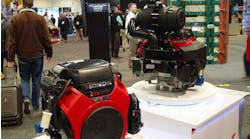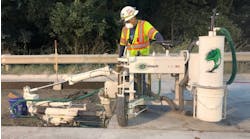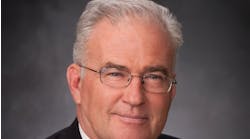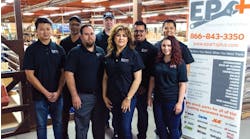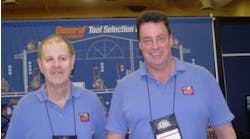Growing Global
Genie Industries discusses its plans for international growth.
Tim Ford joined Redmond, Wash.-based Genie Industries a year and a half ago as CEO, and has grown along with the company. RER editor Michael Roth sat down with Ford at the recent Rental Show, and in this candid interview with RER, Ford analyzes the company's continuing international growth and manufacturing capability around the world.
RER: It looks as though Genie is continuing on a strong growth path.
Ford: For me this has been a great experience to have the opportunity to lead a company that has the position in the industry and the people and the prospects for long-term growth. I don't care what you sell, if you don't have an organization with great people, you don't have anything. This organization continues to amaze me with the quality of people who have been here and the people that come into the company, whether it's at my level or throughout the organization. There's almost a breeding effect that happens when people adapt to the fact that we are about the customer, for the customer and responsive to their needs. If that's not the personality of the person, they either adapt to it or they don't stay.
Saying thank you to the customer for their business is not a hard thing to do, but it's very meaningful. People want to feel that if they spend their hard-earned dollars, that people care.
Tell us about the acquisition of Phoenix Equipment Co.
We went through a process last summer as an organization to figure out, “Where do we want to take the business?” We've had three or four years of fantastic growth, so what's the next chapter for us? And we came up with three critical areas for us. Globalize the business, extend our offering beyond equipment to include services, and extend our offering beyond aerials into a broader set of products, which might mean other Terex offerings or maybe other categories we're not into yet.
Globalization is a key part of our business. We've historically been two-thirds in North America and one-third outside of North America. That revenue mix changed in 2007, partly because of the market demand and partly because we were pushing it in that direction. We're closer to 55/45 in '07 and so we're beginning to manufacture products closer to the customer.
At the same time, there are probably about 10 times as many pieces of equipment in the field than there were 10 years ago, and with that installed base out there, there's a big market for used equipment. Customers are seeking different financial solutions to their cap-ex spend, it makes sense for us to get into refurbishments. We had a long-term relationship with Phoenix Equipment in Waco, Texas. We'd been talking to a few select customers that wanted us to do refurbs and we were effectively outsourcing them to Phoenix. And so through a series of discussions, we decided that it was the right time and place for Phoenix and the right time and place for us to put this together and really to take this under our roof. So in January we concluded the acquisition of Phoenix Equipment. We will be more proactive in how we're trying to sell refurb services to our customers if they want them.
This is part of a larger strategy to offer a variety of services to our channel partners and one of the things that is really important to me is to make sure that it is crystal clear to our customers that our message is to support their businesses, not to compete with their businesses.
What about the Coventry plant in the U.K.?
We're manufacturing small scissorlifts there. It's an amazing story. We designed the manufacturing line in Redmond, and tested it there, we broke it down, we shipped it to England, we assembled it in England and began production of scissors in November. So in nine months we went from no line, not even the idea of a line, to the same rates of production in England that we're doing in Redmond. We will produce between 20 and 25 percent of our unit volume for Europe in Europe.
Will you expand manufacturing to other areas?
We don't have one in China yet, but that's something we're looking at. As part of our globalization strategy we intend to manufacture, by 2010, 50 percent of our production in Europe for Europe, and 30 percent of our production in Asia for Asia. So we're going to go from nothing to a substantial part of a region's production by 2010.
On the one hand, it sounds like “Let's just go build a plant,” but it's pretty complicated. You've got supply chain, you've got infrastructure, those sorts of things you've got to build. But we're committed to and aggressively pursuing that because for us to manufacture in the Pacific Northwest, put the product on a boat and ship it around to Europe or ship it down to Brazil or ship it over to Asia, depending on the location, it could be four to six weeks on the water and a lot of abuse in transit. It's not a productive way for us to use our assets or to serve the customer.
It seems as though competition is once again increasing in the aerial business.
A growing profitable business attracts players and that's what we have here: a business that has long-term potential for growth and is profitable for the manufacturer and the rental company. The same can be said for the rental channel, the people to whom we sell. There are many people that sold their companies and sat on the sideline for several years and are now starting up again.
It gets back to the point that buying the least expensive equipment isn't the most economic way to go in the long run.
Exactly. It's the total cost of ownership, it's the total investment against the total return. That really to me is the essence of what we need to show people. And every day, the bar gets raised. The customer has higher expectations and our customers are creative and capable and confident and our challenge is to make sure that we are staying in front of customer needs, never getting arrogant, never taking the customer for granted, and making sure that we are satisfying their needs with the things that they value.
How does the economy look to you?
The headlines you read in the newspaper and what you hear when you're talking to customers are totally inconsistent. If you read the newspaper, it's doom and gloom, yet when I talk to customers here, they say that utilization rates are high and their rental rates are decent. They are cautious, but the overall world our customers are serving seems relatively OK. It's not robust, it's not like 2005 and 2006, but it's decent.
Are you concerned about the non-residential construction slowing down in response to residential?
Sure, and I think it's reasonable to assume that will happen. But, the utilization of aerial work platforms will continue to grow around the world for the next decade. Infrastructure needs and requirements are growing, the world's population is increasing, economies are improving in countries like China and Brazil and Mexico and India, and all of that breeds the needs for roads, buildings, schools and hospitals. That's all good for the kinds of products that Terex makes and as governments start requiring stricter requirements on work safety regulations, we'll continue to see more applications and use of aerial work platforms in a variety of different spaces.
According to the U.S. Census Bureau, the population of the U.S. alone will grow by 65 million by 2030.
If you look at it on a global basis, there are about 6 billion people in the world today, the forecast is for 9 billion people in the world by 2050. Even if they're half right, you're going to have more people in 2050 than [today] and it's going to require more infrastructure. So I like the space that we're in.
JCB to Build on Record Results in 2007
JCB enjoyed its best-ever year in 2007 with sales and global market share rising to all-time highs, the company said in a press conference at ConExpo in Las Vegas last month.
In 2007, JCB's revenue increased to a record $4.5 billion, compared with $3.5 billion in 2006, an increase of about 28 percent. The company sold more than 72,000 machines in 2007. The Staffordshire, England-based manufacturer said its share of the world construction equipment market rose to 12 percent, compared with 10.4 percent in 2006.
In 2007, India surpassed the United Kingdom as JCB's single largest market with sales of more than 17,000 machines, up from 10,800 units sold in 2006.
JCB officials said the company has retained its position as the world's No. 1 backhoe manufacturer, producing one of every three machines sold globally. JCB also said it was the world's leading manufacturer of telescopic handlers in 2007.
JCB introduced 21 new products, including tracked excavators, mini-excavators, telescopic handlers and skid-steer loaders at ConExpo, bringing its total machine line-up to 290 models.
“Our business has doubled in four years, with sales increasing from 36,000 machines in 2004 to 72,000 last year,” said JCB managing director and CEO John Patterson. “This is an outstanding achievement and testament to the hard work of the JCB workforce and dealers worldwide. This growth has been fueled by the continuous development of new products and a $200 million investment to ensure we have the right manufacturing capacity in the right locations around the world.”
The primary source of growth during 2007 was emerging markets such as India, Bulgaria, Romania, Poland, Russia and South America.
Other JCB highlights included:
-
An increase in global sales of JCB Vibromax equipment by 45 percent.
-
JCB Groundcare sales increased by 60 percent;
-
New products and ranges accounted for 40 percent of total JCB sales increase;
-
Increase in the dealer network to 670 dealers and 1,500 locations worldwide;
-
New Iberian Peninsula Parts Distribution Center opened in Madrid;
-
New range of generator sets launched.
Despite concerns about the credit crunch and downturn in North America, and the pressure U.S. difficulties will put on European economies, JCB is continuing to invest in global production facilities. A $60 million investment to double capacity at the backhoe loader production facility near Delhi, India, is scheduled to be completed this year. Tracked and wheeled excavator production in the U.K. will expand following an $80 million investment in a new heavy products factory, and JCB is about to open a $14 million JCB Attachments factory in Staffordshire.
The company is also developing additional capacity at its World Parts Center in the U.K.; a new warehouse in Moscow for the fast-growing Russia and CIS markets; a Customer Support Center and training facility in JCB's North American headquarters in Savannah, Ga., and a new service parts warehouse and training facility in Pune, India.
“There is nervousness and uncertainty for 2008,” acknowledged Patterson. “But infrastructure developments seem to be strong in most markets and growth in emerging markets will continue. Overall, we hope to be able to grow the business in 2008 by investing in new products, new facilities and in the ongoing strengthening of the JCB network and team around the world.”
At ConExpo, JCB once again presented its Dancing Diggers with an all-new show, involving three backhoe loaders and six telescopic handlers, along with a team of aerial acrobats. The show, entitled “Equilibrium,” was presented every hour at ConExpo.
ConExpo Shatters Attendance Records
ConExpo-Con/Agg 2008 set records for attendance, exhibit space and number of exhibiting companies according to the Association of Equipment Manufacturers. More than 144,600 attendees from more than 130 countries attended the convention, covering more than 2.28 million net square feet of exhibits, with 2,182 exhibitors. About 124,000 attended the 2005 show.
More than 28,000 attendees from outside the United States attended, a 30-percent increase compared with the 2005 show. International attendance increased by more than 50 percent from Latin America and the Caribbean region, and doubled from China, India and Turkey, with significant increases from Canada, Australia, Russia and the Middle East.
The next ConExpo-Con/Agg will be March 22-26, 2011 at the Las Vegas Convention Center.
Volvo Unveils Hybrid Wheel Loader at ConExpo
Volvo Construction Equipment unveiled a pre-production prototype of its L220F Hybrid wheel loader at the ConExpo show in Las Vegas. The unit offers a 10-percent reduction in fuel consumption.
While much of the technology remains confidential, subject to patents pending, the heart of the hybrid system is an integrated starter generator. Fitted between the engine and the transmission, the ISG is coupled to a state-of-the-art battery that has many times the power capacity of a normal lead acid battery, Volvo says.
The ISG is valuable because up to 40 percent of a wheel loader's time can be spent with the engine idling. The ISG allows the diesel engine to be turned off when stationary, and then almost instantly restarted by rapidly spinning the engine up to optimum working speed using a burst of energy from the high-power battery.
The ISG can also overcome diesel engines' traditional problem of low torque at low engine speeds, the company said, by automatically offering a massive electric torque boost, adding up to 50 kW of instant mechanical energy.
Volvo CEO Tony Helsham said at ConExpo that Volvo expects to begin delivering the unit in late 2009.
JLG Introduces ClearSky Connected Asset Technology at ConExpo
JLG Industries unveiled its new telematics system customized for aerial work platforms and for the rental industry. Known as ClearSky, this new connected asset-management tool remotely communicates with equipment to gather vital equipment information and, with the support of intelligent back-office systems, makes it available 24 hours a day. This clear view of equipment information enhances rental companies' ability to make smart decisions affecting machine productivity and equipment lifecycle.
JLG's new system is scheduled to be available as an option on JLG combustion booms, except for the 150HAX, in summer 2008. JLG plans to extend this technology to additional product families.
This customized system offers significant operational advantages that translate into a lower total cost of ownership for equipment owners and end users. Features include:
-
On-demand diagnostics and troubleshooting
-
Preventative maintenance alerts based on real-world operating conditions help reduce unexpected failures
-
Machine maintenance history
-
Operating system integration
-
Geo fencing
-
GPS location with mapping on various levels (local, regional, national.)
“Anticipating the needs and responding to requests of our customers, who are always working to lower their cost of equipment ownership and to increase uptime, JLG's ClearSky is the critical management tool they've been waiting for,” said Craig Paylor, JLG president. “JLG, along with our supplier MasterTrak, has developed a customized telematics system that redefines the word. Ideally suited for the rental industry, ClearSky gives rental companies piece-of-mind knowing that their fleet is operating smoothly and productively.”
Rental companies know where their equipment is. They know when there is a problem and how to fix it. They can be confident that they are not spending money or time needlessly because they always know what needs to be done.”
With JLG's connected asset technology, rental companies are able to recognize a problem before the point of failure. A rental company receives an alert of a problem before an end user calls, “pings” the machine with JLG's unique on-demand feature to analyze the machine operating system, determines the problem and can send a technician with the correct parts to repair the problem. Or, companies can use JLG's expertise in troubleshooting problems by allowing JLG to “ping” the machine and determine the fault for them. These capabilities can save time and money by eliminating unnecessary trips to the field, and by allowing service technicians to arrive equipped with the right tools, parts and training so they are more effective.
Increased rental revenue is another benefit of the technology. The system can identify equipment use once it's been called off-rent, identify machine use beyond contract, and can help preserve pre-lien rights. In addition, rental companies are alerted when equipment goes beyond safe operating parameters, so this new system can help increase safety and identify training needs.
Equipment can have a telematics control unit (TCU) and associated hardware factory installed on new equipment, or retrofitted to existing equipment by authorized installers. The TCU provides a two-way communication link to the machine control system using satellite and cellular technology. The data is transmitted over the network to a data center where it is shared with appropriate users and displayed in various systems including customer operating systems.
MasterTrak is a key supplier to JLG on this new technology. MasterTrak, based in Wood Dale, Ill., provides the next generation of remote monitoring and equipment management solutions to the industrial equipment industry. Their products are designed to deliver cost savings and utilization improvements through the entire equipment lifecycle, impacting equipment reliability and managing total cost of ownership.
JLG Industries, an Oshkosh Corp. company, is based in McConnellsburg, Pa.

